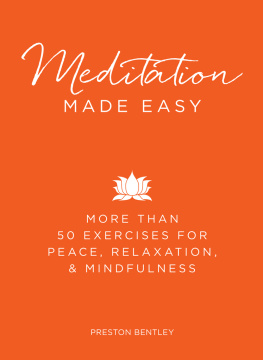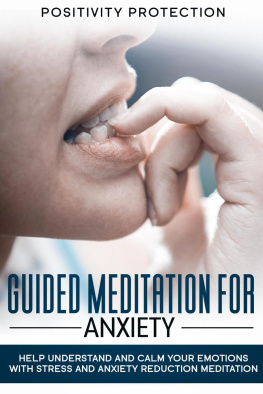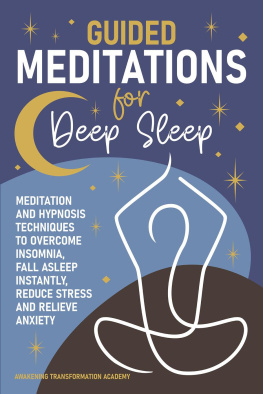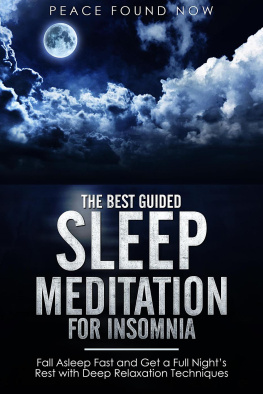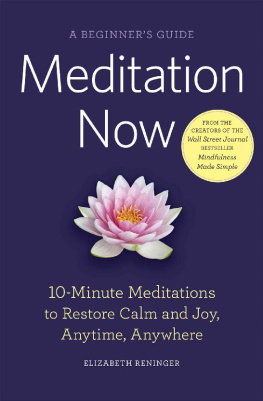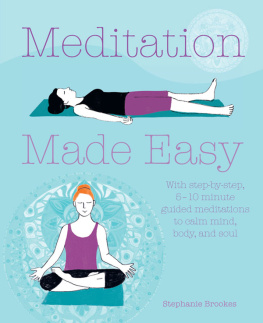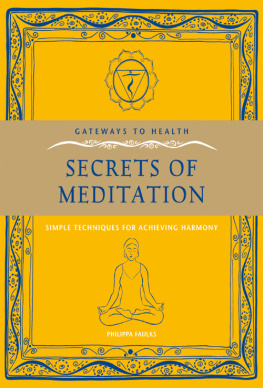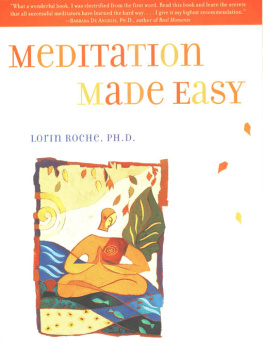Contents
Guide
Meditation
MADE EASY
MORE THAN
50 EXERCISES FOR
PEACE, RELAXATION,
& MINDFULNESS
PRESTON BENTLEY

Avon, Massachusetts
Contents

Introduction

Meditation is supposed to quiet you, to focus your mind on just one thing. Yet these days, who has the time for that?
Sometimes, people think of meditation as sitting in painful positions for hours, just waiting for something to happen. Though sitting still is one way to meditate, there are many other options, too. No matter what you are doing or what is going on in your life, you can choose to do it with your full presence, thereby performing it mindfully. Thats meditation! You can mindfully drink your tea, take a shower, or cook dinner, and all it takes is focus and intention, doing what you do moment by moment, breath by breath. Anything you do mindfully becomes a meditation if you do it with calm and attention. Stretching, executing a yoga pose, and even taking a walk all can be meditations.
As you practice meditation, you will discover the keys that open the door to your potential as a human being. In this place, youll find ways of meeting challenges and coping with problems. Youll also find new ways to engage your life with experience that teaches, heals, and enhances everything around you. It will take some work, but it is a labor of love you deserve.
If discovering greater meaning and purpose in life isnt reason enough to begin a meditation practice, the physical benefits should be. Over the past few decades, evidence has been mounting that suggests that meditation helps to reduce the harmful effects of stressful lifestyles. Want to have more energy? Reduce the risk of a heart attack? Control depression and anxiety? Often, our first response to such problems is to reach for a pill bottle, but perhaps more ancient ways of combating them should be employed alongside modern Western medicine. Perhaps people living thousands of years ago had some wisdom about life that we have lost in our fast-paced, technology-driven societies. And yet, at the same time, our technology and science help us to understand ancient practices better, to find explanations for how and why they work.
The practice of meditation should be at the core of your life. Its the basic tool that allows every act to have meaning and richness. Meditation doesnt have to be a separate, special event that takes you away from your responsibilities or leisure. It can be an ongoing process that is part of everything that you do.
If meditation is an idea you want to explore, what is the best way to go about it? And if you already occasionally meditate, how can you develop and grow with it?
This book offers a simple, approachable introduction to meditation, with a wide variety of exercises you can do at any time of day, no matter where you are. The meditations vary in length and are adaptable and interchangeable, according to your needs. Youll find breathing exercises that can help you quickly calm down in stressful situations, short and long meditations designed to help you slow down and experience what is happening within you and outside of you, prayers and mantras that can help you stay present in the moment and state your intentions for the day, and yoga poses that help you connect whats happening in your mind with whats happening in your body.
Some of these exercises are perfect for when you first wake up in the morning, before youve even gotten out of bed. Others might be just right for a break at work. You might choose to do a morning meditation practice, or perhaps youll find you prefer to meditate before getting ready for bed at night. Sometimes you might enjoy the silence, and other times you might choose to play calming music during your practice. When, where, why, and how you meditate is entirely up to you.
No matter how or why you begin a meditation practice, there is no better time to start than right now. Being in the present is what its all about, and if you enter into the experience with an open heart and mind you will begin to see the benefits in all areas of your life. Get ready to tap into the everyday miracle of meditation by simply setting aside a few minutes each day to foster peace and tranquility.
PART I

Meditation Basics
What Is Meditation?
Youve no doubt heard that meditation can help remedy the ills of modern living: stress, anxiety, depression, and poor health. It is also praised for its healing benefits and positive influence on personal well-being and relationships. But what, exactly, is meditation? In a nutshell, meditation is the stilling of all your conscious faculties in order to be present in the moment. This may be a foreign concept to you, or something you think only enlightened people do. You may also think it requires a lot of time and involves a learning curve. The truth? Meditation is a simple practicesomething anyone can do, anywhere, anytime.
For the purposes of this book, meditation includes anything from simple breathing exercises, to reciting (or merely thinking of) prayers or mantras, to guided imagery, to yoga poses. It can be as simple and as pleasurable as gazing out a window and watching a bird at the feeder. Some meditations last a matter of seconds, while others can last as long as twenty minutes or more. With meditation, there is no right or wrong. When, where, how, and why are all up to you.
Misconceptions about Meditation
When considering meditation, you might first think of a Buddhist monk wearing a robe, sitting cross-legged on a mountaintop, far from the realities of everyday life. With eyes closed, perfect posture, and an immobile expression, the meditator appears to be in another world, above and beyond the demands that the rest of us are dealing with on a daily basis. This image seems neither possible to emulate nor worthwhile as a goal. While that is one way to meditate, its certainly not the only way.
You can meditate in any clothes you want, anywhere thats convenient for you. Meditation requires no special separation from daily life. You do not have to give up your creature comforts in order to embrace meditation. In fact, meditation allows you to appreciate and understand their presence in your life.
In addition, although perfect posture and immobility are skills that you can learn through meditation, they are not the purpose of the practice. Physical conditioning does play a fundamental role in meditation, but you dont have to stand on your head or contort your body to achieve balance or harmony. Natural postures, movements, and breathing are all that you need to start a meditation practice. You may quickly learn, however, that what you have been doing for some time is not natural after all. For example, when you sit in a chair without thinking about it, you might actually be hunched over or slouching. Paying close attention to your body is one part of learning to meditate.
You Might Already Be Meditating Without Knowing It!

